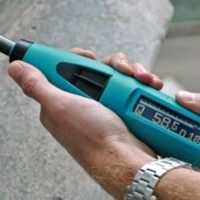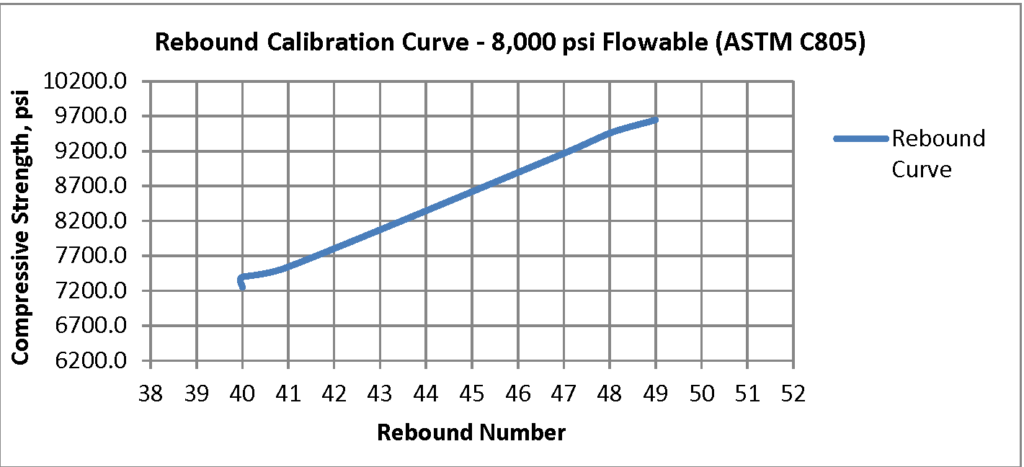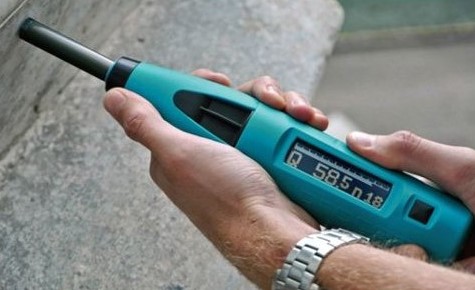When assessing potential problems in concrete structures, consider a non-destructive test using the concrete test hammer, AKA “rebound hammer,” before investing a lot of time and money needlessly replacing or destructively testing the concrete structure. The use of rebound hammer tests should be considered before you or your client decide to drill multiple core samples. Large areas of the concrete structure suspected of having potential strength problems can be tested quickly with a rebound hammer. Analysis of those results can narrow down specific areas for more rigorous testing.
A rebound hammer consists of a spring-loaded steel hammer which, when released, strikes a steel plunger in contact with the concrete surface. The spring-loaded hammer must travel with a consistent and reproducible velocity. The rebound distance of the steel hammer from the steel plunger is measured on a scale attached to the frame of the instrument, giving you the Hr number.
The rebound hammer test is used to assess the in-place uniformity of concrete, to delineate regions in a structure of poor quality or deteriorated concrete, and to estimate in-place strength development. The non-uniform area can become a target area for further testing. The further testing is used to establish the relationship between the rebound number and the compressive strength.
For a given concrete mixture, the rebound number is affected by factors such as moisture content of the test surface, the method used to obtain the test surface (type of form material or type of finishing), and the depth of carbonation. These factors need to be considered in preparing the strength relationship and interpreting test results. To estimate strength in an existing structure, establish the relationship by correlating rebound numbers measured on the structure with the strengths of cores taken from specified locations.
Uniformity is not the same as strength. It should be noted that according to the American Concrete Institute (ACI) Provision 1.6.4.2 of ACI 301-16, a rebound hammer cannot be directly used for in-place strength testing. However, this same provision allows use of a rebound hammer in accordance with ASTM C805/C805M, if specified by the Architect/Engineer, only “to evaluate uniformity of in-place concrete or to select areas to be cored.” At the same time, Provision 1.6.5.3(a) states: “Results of in-place strength tests will be evaluated by Architect/Engineer and are valid only if tests are conducted using properly calibrated equipment in accordance with recognized standard procedures and an acceptable correlation between test results and concrete compressive strength is established and submitted.” However, no specific non-destructive testing methods or equipment for in-place strength evaluation are listed. For a review of in-place methods for estimating concrete strength, including the rebound hammer, refer to ACI 228.1R.
This testing procedure might help avoid having to use ground penetrating radar and then drilling core samples for compressive strength tests. It is designed to provide data in the field on concrete structures without causing damage and gives an immediate indication of uniformity. It is economical, quick, and simple to use. Its results can be used to estimate compressive strength for the structure. If you have concrete in question, consider the use of a rebound hammer test along with a thorough visual inspection as part of the first steps in the investigation of the structure.
Founded in 1997, The Warren Group, forensic engineers and consultants provides technical investigations and analysis of personal injury and property claims as well as expert testimony for insurance adjusters and attorneys. Extremely well versed in the disciplines of mechanical, electrical, chemical, structural, accident reconstruction and fire and explosion investigation, our engineers and consultants are known for delivering the truth — origin, cause, responsibility and cost of an event or claim — with unmistakable clarity.








